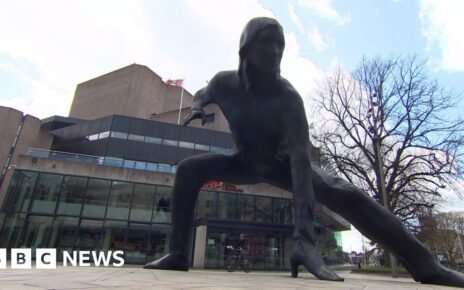[ad_1]
 PA Media
PA MediaWorld-famous graffiti artist Banksy has concluded his animal trail, after nine days of pop-up artworks dotted around the capital ended with a piece on the shutters of London Zoo.
Although all the surprise pieces have now been unveiled, speculation over the inspiration behind them persists. What do they mean, and how have they been received by the art and graffiti worlds?
Banksy’s final piece, outside London Zoo in Camden, north London, shows a gorilla lifting the shutter to release a sea lion and birds, while other animals appear to look on from the inside.
But the series of artworks was set in motion with a piece on 5 August appearing to show a goat perched on a ledge as rocks fall on a wall in Kew Green in Richmond, south-west London.
This was swiftly followed on 6 August with a work depicting two elephants reaching for each other’s trunks, and three monkeys hanging from a railway bridge in Brick Lane, east London, on 7 August.
By day three, online speculation was rife as to whether the series had a deeper meaning.
 PA Media
PA MediaPerhaps the goat was a metaphor for standing on the edge of a moment of change, or the two elephants were reaching across from different sides of something? Maybe the three monkeys represented the “wise monkeys” in the Japanese proverb of the “see no evil, hear no evil, speak no evil” fame?
 PA Media
PA MediaTheories have ranged from the series focusing on social division amidst recent riots, to the Israel-Gaza conflict.
James Ryan, CEO of Grove Gallery which sells Banksy originals and prints, told BBC London he initially thought the works had “politically charged and motivated messages, so the goat – references to Palestine and Gaza, and then the wolf crying for help – some kind of persecution”.
Since the final piece was revealed, however, he believes there is a theme of “incarceration; animals being trapped” in the series.
 PA Media
PA MediaMr Ryan added while there were new elements to Banksy’s campaign such as building momentum by posting a daily “teaser” on social media, there were also references to his previous work with the gorilla piece being reminiscent of his 2006 “Sweep It Under the Carpet” work depicting a maid with a dustpan and brush which was also painted in north London.
 Getty Images
Getty Images Getty Images
Getty ImagesJames Peak, presenter of the BBC’s The Banksy Story, explained the artist was “very keen on animal welfare” and “helped Greenpeace out with a campaign a few years ago”.
He said the artist also made ecological themes part of his work in the past, writing cardboard placards and throwing them into the ape enclosures at Longleat and Melbourne Zoo in Australia, “so the apes were holding up bits of cardboard saying things like ‘please help me I’m the victim of a cruel scientific experiment’ or even ‘I’m a celebrity get me out of here’.”
 Getty Images
Getty Images PA Media
PA MediaHe added Banksy campaigns “often only really make sense backwards”.
This series could simply represent “this grand great escape that the gorilla has caused from London Zoo, which explains why there are all these animals over London this last week”, he said.
Or it could have “a really serious kind of point to it – maybe that we’re not doing enough to ensure animals globally have enough natural space,” he added.
The pieces haven’t been without their share of problems either.
The howling wolf sprayed on a satellite dish in Peckham, south-east London, was seemingly taken by thieves.
 PA Media
PA MediaTwo others were removed by London authorities, with the first – a silhouette of a cat painted on a billboard on Edgware Road in Cricklewood – was taken down for safety reasons.
The City of London Corporation said the other painted on 11 August – swimming piranhas on a City of London Police sentry box – had been taken to Guildhall Yard so it could be viewed safely.
 PA Media
PA MediaTwo more were defaced, including the two elephants which received some spray-painted white stripes.
However, it is the vandalism on the second-to-last artwork, of a rhinoceros (originally mounting a Nissan Micra with a traffic cone on its bonnet) in Charlton, south-east London, which resurrected an old feud between Banksy and his revered rival Robbo.

Ahmad Karkouti, from graffiti and street art podcast Arms House to your Mums House, told BBC London the white S, or a dollar sign, and a V sign stood for a local graffiti crew called South Vandals.
He added he received footage of the defacing with the message “South Vandals 4 life! Team Robbo”.
Mr Karkouti explained the late Robbo, who was from London, was inspired by differences in the way socially acceptable street art was appreciated compared to traditional graffiti, which was widely regarded as criminal damage.
While hidden meanings and wider battles are still up for debate, one thing clear in enthusiasts’ eyes is that Banksy has successfully grabbed the world’s attention – again.
Mr Ryan said the series has “had the desired effect that he wanted”, to “create this theatre” which “reaffirms” his status as a “trendsetter”.
Mr Peak agrees.
“This campaign has been eight, nine days and it’s fantastic. It’s got all of London and all of the UK talking.”
[ad_2]
Source link freeslots dinogame telegram营销




